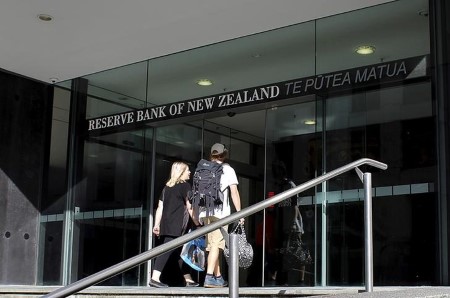(Recasts 1st paragraph and other parts of text to add interview with RBNZ assistant governor)
- RBNZ keeps interest rates steady at 1.75 percent
- Foils expectations for a more dovish tone
- All ingredients there for house price rise-McDermott
New Zealand's central bank said on Thursday it was slightly more uncomfortable with the high level of the local dollar than it had been in May, but ruled out the need to cut rates from the current record lows as it expects inflation to gradually pick up.
Sticking with its neutral policy stance, the Reserve Bank of New Zealand (RBNZ) said it did not see the benchmark official cash rate rising for "the foreseeable future" either, after keeping it at 1.75 percent for a fifth consecutive rate review.
The central bank said a lower New Zealand dollar was "needed" to increase import-driven inflation and help deliver more balanced growth, a slight change from June when it said a lower currency "would help" rebalance the growth outlook.
RBNZ Assistant Governor John McDermott told Reuters this most subtle of changes was aimed at communicating the bank's growing discomfort to the market, while recognising that some would have been disappointed they didn't use stronger language.
"We haven't become more relaxed with the currency, in fact if anything, we are just slightly more uncomfortable," RBNZ assistant governor John McDermott told Reuters in an interview.
"It's fair to say the market should recognise our discomfort with what happened," he said referring to the currency's rise.
The New Zealand dollar, which is up nearly 6 percent this year, jumped briefly to $0.7371 after the policy statement was released as some perceived the RBNZ as being more relaxed about the strength of the currency. The kiwi later gave up those gains on broad risk-aversion amid simmering tensions in the Korean peninsula.
The RBNZ said it did not see the need to cut rates as capacity pressures would gradually push inflation higher, currently running at an annual 1.7 percent or around the middle of the central bank's 1-3 percent target.
GROWTH OUTLOOK RBNZ Governor Graeme Wheeler said during his last rates decision before his five-year term ends next month that monetary policy would remain accommodative for a while yet, sticking to the language of recent statements.
All 21 economists in a Reuters poll had forecast the central bank would stay put on Thursday, but some had expected it to strike a more dovish tone by acknowledging the recent run of softer data or adjusting its inflation and interest rate forecasts.
But the changes to its forecasts were limited. The central bank sees inflation slowing this year by more than forecast in the May statement, although it expects consumer prices to rise 2.0 percent in the first quarter of 2020 - broadly in line with forecasts in the May statement.
The bank made no changes to its official cash rate forecasts, which project rates will rise in early 2020.
"We were expecting a little bit more dovishness within the statement, but clearly it shows that it's not going to take one or two data points to shift the RBNZ," said Philip Borkin, senior economist at ANZ.
New Zealand has seen some of the fastest growth among advanced economies in recent years, but recent data pointed to a loss of momentum. House prices have also cooled from the double-digits in the start of 2017 but the central bank remains wary about a rebound.
"On what sits behind the concern is the strong population growth – so underlying demand hasn't gone," McDermott said, noting that lower rates meant financing costs are cheap.
"So you've got all the ingredients for a resurgence."
- Forums
- NZX - General
- News: NZ central bank says displeased with high NZ dlr, sticks to neutral stance






